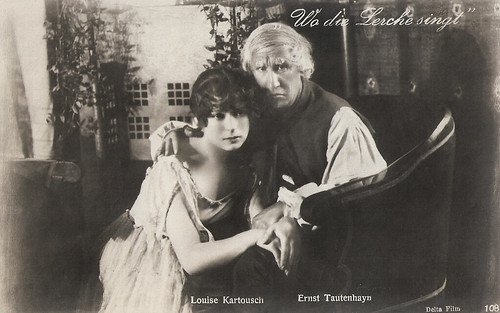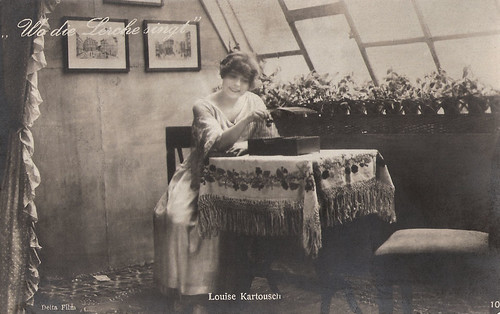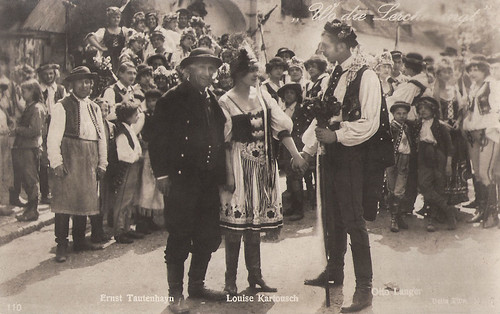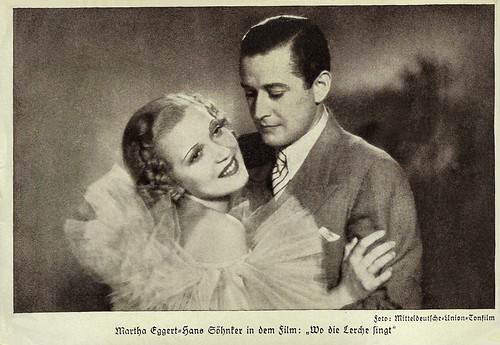Wo die Lerche singt/Where the Lark Sings (Hubert Marischka, 1918) is the first film adaptation of the 1918 operetta of the same name by Hungarian composer Franz Lehár. Director Hubert Marischka was a popular Operetta star and director in Vienna and made contact early on with the new medium of film, in which he worked as actor, director and screenwriter.

German postcard by B.K.W.I., no. 100. Photo: Delta-Film. Publicity still for Wo die Lerche singt/Where the Lark Sings (Hubert Marischka, 1918). From left to right: Louise Kartousch, director/actor Hubert Marischka, composer Franz Lehár and Ernst Tautenhayn.

German postcard by B.K.W.I., no. 103. Photo: Delta-Film. Publicity still for Wo die Lerche singt/Where the Lark Sings (Hubert Marischka, 1918) with Ernst Tautenhayn.

German postcard by B.K.W.I., no. 107. Photo: Delta-Film. Publicity still for Wo die Lerche singt/Where the Lark Sings (Hubert Marischka, 1918) with Ernst Tautenhayn, Louise Kartousch and Mariette Weber.
The libretto of the operetta Wo die Lerche singt by A. M. Willner and Heinz Reichert was inspired by the stage play Dorf und Stadt (Village and City) by Charlotte Birch-Pfeiffer.
The operetta premiered at the Royal Opera in Budapest on 1 January 1918. It was one of Franz Lehár's most successful wartime operettas.
Margit, a young Hungarian country girl (in the film played by Louise Kartousch) travels to a big city where she is seduced and then abandoned by an artist (Hubert Marischka).
Eventually she returns home to the countryside "where the larks sing" and is reconciled with her peasant fiance Pista (Otto Langer). Ernst Tautenhayn played Margit's uncle, the old farmer Törö Pá.
In 1936 the operetta was again adapted into an Operetta film, Wo die Lerche singt/Where the Lark Sings (Carl Lamac, 1936) starring Márta Eggerth. It was a co-production between Hungary, Germany and Switzerland.

German postcard by B.K.W.I., no. 108. Photo: Delta-Film. Publicity still for Wo die Lerche singt/Where the Lark Sings (Hubert Marischka, 1918) with Louise Kartousch and Ernst Tautenhayn.

German postcard by B.K.W.I., no. 109 Photo: Delta-Film. Publicity still for Wo die Lerche singt/Where the Lark Sings (Hubert Marischka, 1918) with Louise Kartousch.

German postcard by B.K.W.I., no. 110. Photo: Delta-Film. Publicity still for Wo die Lerche singt/Where the Lark Sings (Hubert Marischka, 1918) with Ernst Tautenhayn, Louise Kartousch and Otto Langer.

German postcard by B.K.W.L. Photo: Ludwig Gutmann, 1918. Publicity still for Wo die Lerche singt/Where the Lark Sings (Hubert Marischka, 1918). Caption: "Wo ist denn der Mann mit der schönen Frau?" (Where is the man with the beautiful woman?)

Martha Eggerth and Hans Söhnker in the 1936 sound version of Wo die Lerche singt. German card. Photo: Mitteldeutsche Union Tonfilm. Publicity still for Wo die Lerche singt/Where the Lark Sings (Karel Lamac, 1936).
Sources: Wikipedia (German and English) and IMDb.

German postcard by B.K.W.I., no. 100. Photo: Delta-Film. Publicity still for Wo die Lerche singt/Where the Lark Sings (Hubert Marischka, 1918). From left to right: Louise Kartousch, director/actor Hubert Marischka, composer Franz Lehár and Ernst Tautenhayn.

German postcard by B.K.W.I., no. 103. Photo: Delta-Film. Publicity still for Wo die Lerche singt/Where the Lark Sings (Hubert Marischka, 1918) with Ernst Tautenhayn.

German postcard by B.K.W.I., no. 107. Photo: Delta-Film. Publicity still for Wo die Lerche singt/Where the Lark Sings (Hubert Marischka, 1918) with Ernst Tautenhayn, Louise Kartousch and Mariette Weber.
A country girl in the big city
The libretto of the operetta Wo die Lerche singt by A. M. Willner and Heinz Reichert was inspired by the stage play Dorf und Stadt (Village and City) by Charlotte Birch-Pfeiffer.
The operetta premiered at the Royal Opera in Budapest on 1 January 1918. It was one of Franz Lehár's most successful wartime operettas.
Margit, a young Hungarian country girl (in the film played by Louise Kartousch) travels to a big city where she is seduced and then abandoned by an artist (Hubert Marischka).
Eventually she returns home to the countryside "where the larks sing" and is reconciled with her peasant fiance Pista (Otto Langer). Ernst Tautenhayn played Margit's uncle, the old farmer Törö Pá.
In 1936 the operetta was again adapted into an Operetta film, Wo die Lerche singt/Where the Lark Sings (Carl Lamac, 1936) starring Márta Eggerth. It was a co-production between Hungary, Germany and Switzerland.

German postcard by B.K.W.I., no. 108. Photo: Delta-Film. Publicity still for Wo die Lerche singt/Where the Lark Sings (Hubert Marischka, 1918) with Louise Kartousch and Ernst Tautenhayn.

German postcard by B.K.W.I., no. 109 Photo: Delta-Film. Publicity still for Wo die Lerche singt/Where the Lark Sings (Hubert Marischka, 1918) with Louise Kartousch.

German postcard by B.K.W.I., no. 110. Photo: Delta-Film. Publicity still for Wo die Lerche singt/Where the Lark Sings (Hubert Marischka, 1918) with Ernst Tautenhayn, Louise Kartousch and Otto Langer.

German postcard by B.K.W.L. Photo: Ludwig Gutmann, 1918. Publicity still for Wo die Lerche singt/Where the Lark Sings (Hubert Marischka, 1918). Caption: "Wo ist denn der Mann mit der schönen Frau?" (Where is the man with the beautiful woman?)

Martha Eggerth and Hans Söhnker in the 1936 sound version of Wo die Lerche singt. German card. Photo: Mitteldeutsche Union Tonfilm. Publicity still for Wo die Lerche singt/Where the Lark Sings (Karel Lamac, 1936).
Sources: Wikipedia (German and English) and IMDb.
No comments:
Post a Comment